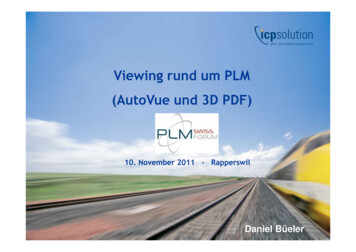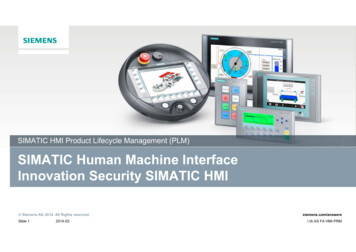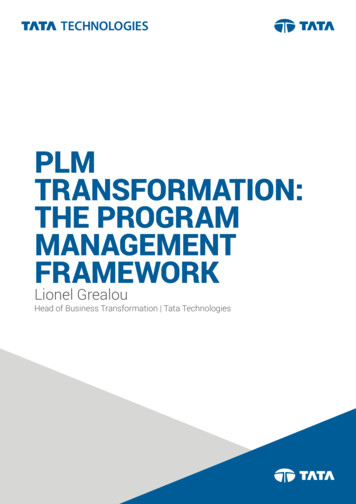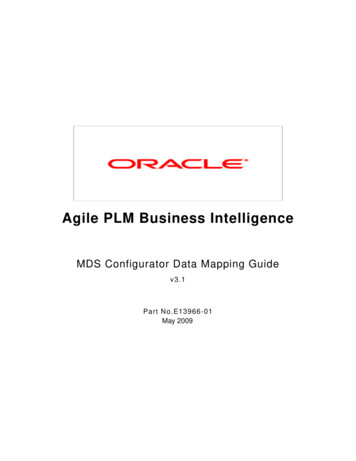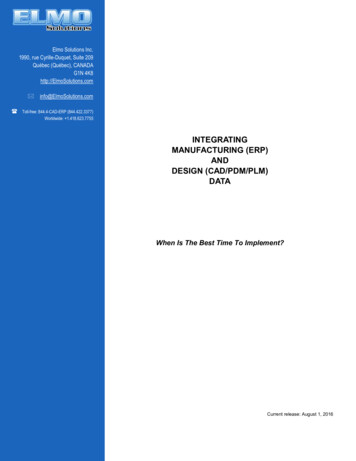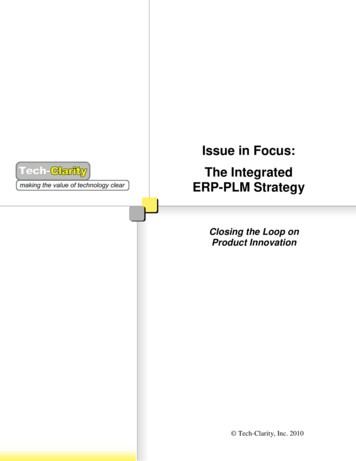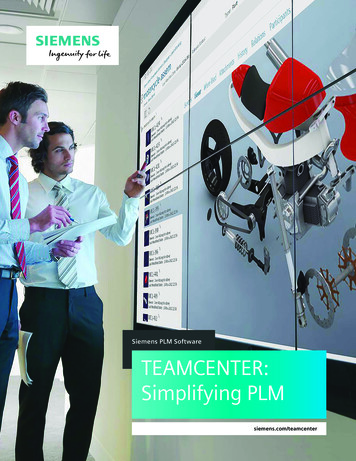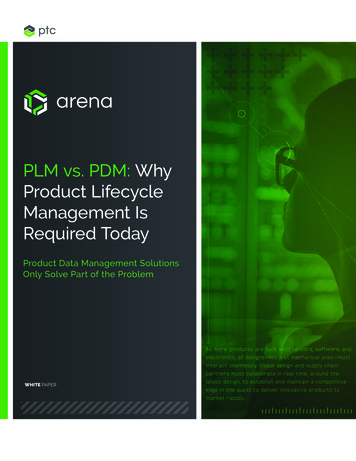
Transcription
PLM vs. PDM: Why Product LifecycleManagement IsRequired TodayProduct Data Management Solutions Only Solve Part of the ProblemWHITE PAPER
PLM vs. PDM: Why P roduct Lifecycle Management Is Required TodayMODERN PRODUCT DEVELOPMENTIn the past, mechanical engineers createddesigns and shared them with internalteams on the shop floor, often withinthe same building. Iterative changesto the designs were introduced duringprototyping, as needed. Throughoutthe process, mechanical engineering,manufacturing engineering, componentengineering, and procurement teamsworked closely together to ensure thatdesigns were manufacturable, costeffective, and compliant to regulations.We had to be ableto iterate quickly ondesigns, track changes,and link related productinformation to scale andspeed marketability.—Ratana Lee, Senior Manager,NPI Master Archivist, NEXTrackerHowever, connected technologies have changed product development dramatically.Fewer products involve mechanical-only designs as companies try to leverage many newtechnologies aimed at connecting people, data, and products. In addition, design teamsare more distributed and often involve external partners. As more products are built withsensors, software, and electronics, all designs—not just mechanical ones—must interactseamlessly. Global design and supply chain partners must collaborate in real time, aroundthe latest design, to establish and maintain a competitive edge in the quest to deliverinnovative products to market rapidly.02
PLM vs. PDM: Why P roduct Lifecycle Management Is Required TodayHOW WE GOT HERE Product complexity is greater than ever: Incorporating electronic and softwarecomponents into traditional mechanical designs has led to additional requirements,more complex integrations, and the need for interoperability. Mechanical engineeringteams must stay aligned with electrical and software design teams to avoid costlydesign errors and new product development (NPD) delays. The pace of innovation isincreasing: The Internet ofThings (IoT), robotics, augmentedreality (AR), virtual reality (VR),and other new technologiesare pushing the limits to designand manufacturing. Highlydispersed teams must be able tomove rapidly through the entireproduct lifecycle while avoidingproduct design, quality, andmanufacturing issues. Outsourcing is the norm:Today, most companies heavilyoutsource with multiple contractmanufacturing (CM) partners,suppliers, and design partners.While outsourcing allows formore specialization, it alsointroduces significant challenges. Without a way to securely manage, share, andcollaborate around the entire product design, teams risk confusion that can lead tobuilding or shipping the wrong revision of products. Regulatory and environmental compliance requirements are demanding andevolving: To ensure compliance with an increasing number of standards orregulations—including ISO, FDA, RoHS and REACH—today’s complex productcompanies need to track and manage compliance effectively.In this demanding global economy, companies must find innovative ways to optimize thepath from design to production to ensure success.Arena invented software-as-a-service (SaaS) product lifecycle management (PLM). Today,Arena offers a wide-ranging set of solutions to speed product development and launches.We understand the daily challenges companies face in turning designs into real products,and we have sold to more than 1,300 companies in the high tech, consumer electronics,and medical device industries.03
PLM vs. PDM: Why P roduct Lifecycle Management Is Required TodayTHE EVOLUTION OF TOOLSAs the nature of product development continues to evolve, manufacturers must keeppace with technology to deliver innovative, high-quality products fast. There are manytools and solutions used by design and manufacturing t eams, including mechanical CAD(mCAD), electrical design automation (EDA/eCAD), product data management (PDM), and enterprise resource planning (ERP). These solutions all play roles in the NPD andnew product introduction ( NPI) process, but none were designed to aggregate the entireproduct design comprised of electrical, mechanical, and software components, or theassociated suppliers, drawings, specifications, and files. Furthermore, these t ypes ofsolutions were not created to speed engineering change processes with secure, real-timecollaboration among distributed teams and supply chains.mCADMechanical engineers takeproduct requirements andtransform them into effectivedesigns using mCAD software.The design output is managed indrawings, 3D models, and otherfiles. The assembly can alsoinclude the bill of materials (BOM),but it’s the BOM for mechanicaldesign only.EDA/eCADFor products with electricalcomponents, electrical engineerscreate designs with EDAtools. These designs includeschematics, Gerber files, netlists,and electrical BOMs. Ensuring interoperability between mechanical and electronicassemblies is a complex and time-consuming endeavor.PDMPDM tools are often employed to manage mechanical designs within a sharedengineering workgroup. PDM provides a data repository for mechanical designs byallowing multiple engineers to collaborate, share files, control the checkout and check-inprocesses, and eliminate overwriting any version of the design accidentally. PDM toolsare primarily used by mechanical engineering teams to coordinate efforts with each otherduring the design phase.PLMPLM is designed to speed the entire concept-to-production process by bringing theengineering designs together and sharing these beyond the individual engineeringworkgroups. As the rest of the product team members get involved—from quality tomanufacturing to procurement—everyone can review the entire design and providetheir input before releasing the final product and starting the planning and product04
PLM vs. PDM: Why P roduct Lifecycle Management Is Required TodayExtended ProcessesIntegration to Design& ManufacturingSourcing & ComplianceSupply Chain CollaborationEngineering ChangeProcessesControl Files & DocumentsPre & Post Production RevisionsStructured RelationshipCore BOM Definitionprocess. The innovative designs, in the form of 3D models, drawings, specifications, andschematics, will be married together in PLM and transformed into products after manyiterative design changes have been made. Each member of the product team will do theirpart to make sure cost-effective and compliant components can be sourced, built, andshipped to meet the customer demand. PLM will manage all items, assemblies (BOMs),engineering change orders (ECOs), approved manufacturers and vendors lists (AML/AVL), and compliance status. For a product to be manufactured at a low cost, on time, andwith high quality, mechanical design teams must collaborate with electrical and softwaredesign teams, component suppliers, and even contract manufacturers. Everyone involvedin designing, testing, and producing the final product must be able to work together in asingle system. mCAD, PDM, and other design tools are not cloud-based or intended to beused by non-technical teams outside of engineering.SpreadsheetsSolutionsCADPDMERPPLM05
PLM vs. PDM: Why P roduct Lifecycle Management Is Required TodayTHE PROBLEMSpreadsheets, CAD, ERP, or pointsolutions are used by engineering andproduction teams. Companies that relyon patch-quilt solutions, ranging fromspreadsheets to documents to socialcollaboration or file storage apps, findthemselves with too many silos that aredisconnected from a controlled productrecord.PROCUREMENTSUPPLY CHAINOPERATIONSENGINEERINGTHE SOLUTIONPLM bridges the gap to ensure the entire design works well together with a high degreeof quality and under cost targets. Ensuring interoperability is easier when the electrical,mechanical, and software solutions are brought together into a single system for allteams to ocsERPMESSoftwareEDACRMQCSourceSCMMANAGING COMPLEX BOMSA typical BOM comprises thousands of electrical, mechanical, and software components.It is highly relational and includes everything needed (like a recipe) to build the finishedproduct. For complex BOMs, companies need more intelligent BOM managementsolutions that modern PLM systems can provide. Throughout the development process,the BOM and its components change often, requiring testing between each aspect of thedesign.Before cloud-based PLM, product companies relied on spreadsheets, documents,and repositories to manage changes to the BOM and related product information. Thisinformation was then shared via phone, fax, or email, with no way to ensure that the datawas current and accurate.06
PLM vs. PDM: Why P roduct Lifecycle Management Is Required TodayThis made remote collaboration challenging andslowed time to market considerably.In addition to spreadsheets, companies also used avariety of other static applications not specific to theneeds of manufacturers, such as Microsoft Word,PDF files, and plain text files, to record and shareproduct information. All fell short in effective changecontrol and information sharing.Though many companies have evolved theirprocesses from that point, there is still amisconception that enterprise resource planning(ERP) systems can be used to manage all productinformation after design—including changesand communication. Unfortunately, even thoughthe final production BOMs, the item master, andcosting information are ultimately loaded intoERP systems, these systems do not have integralprocesses for engineering change orders (ECOs)or fi le management. Therefore, they cannot beused to control BOM or item changes or to manageassociated files. Furthermore, as a tool primarily forinternal groups, ERP systems cannot be used byexternal partners and suppliers to obtain productinformation.Additionally, during the product development andmanufacturing process, it is often useful to traceback the changes to specific revisions of the BOMand make design or part comparisons. It is nearlyimpossible to do so with a collection of BOMrevisions in different spreadsheets.Securely Extend to YourSupply Chain TeamYour product processesinvolve multiple teams,locations, partners,suppliers, and vendors.These dispersed teamsmust comply with the latestregulations and standards.They need to work fromthe same design, stay onbudget, and respond tocustomer demands. Ensureprocesses are followed andeveryone is collaborating.Worldwide66%of customers and theirsupply chain partners useArena from outside theUnited States every dayIndustryStandard92%of top EMS providers inthe industry access Arenacustomer systems forproduct collaboration07
PLM vs. PDM: Why P roduct Lifecycle Management Is Required TodayTHE GAP BETWEEN ENGINEERING ANDMANUFACTURINGThere is a gap between engineering design tools with PDM vaults and the completeproduct record for all aspects of the design with associated documents, specifications,and drawings. Design systems are not created to enable non-engineering teams andsupply chain partners to access information in a way that can be controlled and reviewedeasily. When left unaddressed, this gap impedes the process of turning innovativedesigns into marketable products due to the following issues: Wasted time: Mechanical engineers have to spend more time looking for andcompiling the right design data and product information for the downstreamsupply chain activities including sourcing, planning, manufacturing, and ensuringenvironmental and regulatory compliance. This reduces their ability to focus onpure innovative designs. Without a single, shared source of truth (PLM system) tocollaborate, engineers have to address many questions. Inability to share with external partners: Much of the product information resides, andis only accessible, inside the firewall. Suppliers are not able to directly access the latestproduct and assembly information, making it difficult for t hem to stay aligned withevolving designs. Lack of visibility early in the design process: Similarly, without direct access toproduct information, contract manufacturers lack the necessary visibility required toprovide valuable feedback on the manufacturability of a design early in the process. Asa result, more costly design changes are made further into the development phase. Building to the wrong revision: Without a single system for the entire product recordand associated ECOs, CMs are not able to source and build the latest revision of theproduct. This drives up the cost of goods and results in more scrap and rework or fieldservice issues when the wrong revision of products ship to customers. Compliance problems: Meeting ever-evolving regulatory compliance standards andlaws increases the need for greater collaboration between engineering, purchasing,and manufacturing teams. Without the ability to track and ensure compliance,companies take more risks that can result in penalties, fines, lawsuits, and even harmto customers.BRIDGING THE GAPHaving a single system for the entire product record bridges the engineering designand manufacturing world. For maximum efficiency, systems should be easy to deploy,configure, and access by any member of the supply chain.Engineering teams, especially those responsible for mechanical design, have relied onmany different and sophisticated CAD systems. They have been able t o solve problemsfor shared designs with workgroups through PDM. However, those same teams nowunderstand that with more connected technologies, it’s critical to collaborate early andoften with electrical and software engineering. Furthermore, they must be able to bring a08
PLM vs. PDM: Why P roduct Lifecycle Management Is Required Todaycomplete design to manufacturing quickly.PLM was designed to bridge the gap andprovide a clean hand-off from engineeringto manufacturing.PLM helps all key stakeholders in theproduct development and launch processto better control the design, share ideas,and eliminate delays getting productsto market. Here are the keys to speedingproduct launch time: Access to latest design: Everyone hasthe appropriate level of access to thelatest design files.We get terrific feedbackfrom the give and takeof the review process.Indeed, partners haveprovided feedback thathelped us avoid makingunnecessary, confusing,or costly changes.—David Sangster , COO, Nutanix Faster reviews and approvals: Automated change control processes ensure that teamsget proactive notice to review and approve changes to the product design. Theseelectronic change processes provide better traceability (or an audit trail) between allrevisions of the product, quality issues, and all internal and external teams. Reduced cost and overhead: With earlier access to the entire product design, CMs canprovide feedback on manufacturability issues and/or suggest potential ways to cutcosts (e.g., changing suppliers or component sources). Improved compliance: PLM offers connected information from the company-specificpart number to the source AML number, through the AVL (purchased) number. Cloudbased PLM solutions have business-ready integrations to component databases likeSiliconExpert and Octopart to make it easy to find, source, and use parts that meetenvironmental compliance standards like RoHS and REACH.09
PLM vs. PDM: Why P roduct Lifecycle Management Is Required TodayCAD WITH PDM DRIVES DESIGN, BUT PLMSPEEDS COMPLETE PRODUCT LAUNCHEvery design team needs one of several mechanical, electrical, and/or software designtools, but they all need a single solution to bring the design together for sharing withthe extended product teams. The days of working in siloed design teams and throwingdesigns over the wall to manufacturing are gone. With new connected technologieslike IoT, AR, VR, and robotics, electronics and software play critical roles in productdevelopment. Being able to assemble the design and ensure interoperability at everystep of the NPD and NPI process is key to success.NPDCONCEPTNPIDEVELOPMENTNPDI PROCESSLAUNCHArena’s cloud-based PLM solution was designed to help complex product companieswith distributed teams and global supply chains interact in real time anytime andanywhere. Arena invented SaaS PLM and has driven innovation for more than 1,300companies across the globe. Companies today require systems that are easy to deploy,configure, and maintain. Arena helps small to global-sized companies scale theirdevelopment and production operations by making it simple to use and connect toexisting upstream and downstream systems.So, if you’re tired of trying to get by with yesterday’s tools that create team and productsilos, check out Arena PLM and learn why the leading innovators rely on us to design,produce, and deliver high-quality products fast.010
Copyright 2022 PTC, Inc. All Rights Reserved. www.ptc.com
Arena invented software-as-a-service (SaaS) product lifecycle management (PLM). Today, Arena offers a wide-ranging set of solutions to speed product development and launches. We understand the daily challenges companies face in turning designs into real products, and we have sold to more than 1,300 companies in the high tech, consumer electronics,


